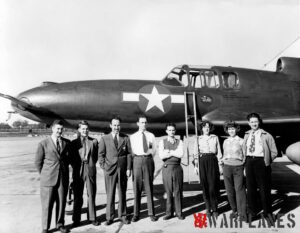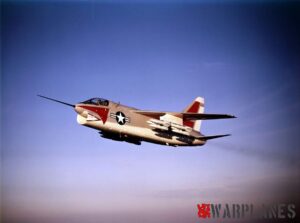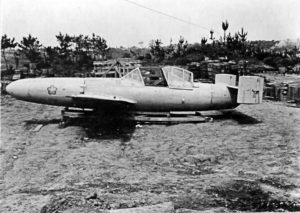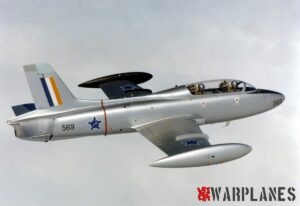S.P.A.D. XII
The airplane is a pure compromise and for a fighter plane, armament presents one of them. Several fighters from WW2 have central armament, where most of the armament was positioned in the fuselage with cannon firing through the propeller shaft. The benefits are obvious, placing of armament in the prop shaft removes the need for synchronization (important when firing through the propeller arc) and therefore this design has a faster rate of fire. The icon of WW2, the Messerschmitt Bf 109, did have central armament. But the very first one to use this in combat was the French fighter SPAD XII from WW1.

If the SPAD XII is the only WWI fighter equipped with heavy armament to have been produced in series, it’s due to the intervention of the most famous French ace Georges Guynemer. During the fall of 1916 he had to face too much jamming of his machine guns during combat and noted that the Hispano-Suiza 8 Aa 150hp was lacking of power to face the new German adversaries. He began (probably circa October 1916) to envisage the creation of a development of the SPAD VII, more powerful and having a better armament thanks to a cannon. He contacted Louis Bécheraut, the technical director of SPAD (Société anonyme Pour l’Aviation et ses Dérivés) with who he was a friend, asking him to realize the drawings of such an aircraft. The first time it is spoken about the aircraft is in a report of 10 December 1916 and designation was SPAD XII Canon 1 or Ca 1 (Ca from Canon). The French mounted 37mm and 47mm on Voisin Type 4 and type 8 bomber aircraft.
Development
A 37mm S.A.M.C. cannon was positioned in the V formed by the cylinders and firing through the propeller shaft. It was 40 to 45 kilograms weight and it included 10 to 12 cannon shells. It was an idea Birkigt had one year earlier but that had no success at this time. A synchronized machinegun 7,65mm Vickers with 400 rounds was fixed on the right of the engine cover. It would have been interesting that the total length of the cannon would have been shortened because the rear of the cannon was extending until the pilot’s legs! So it was impossible to install a traditional stick and Guynemer sent a letter to Béchereau asking for the installation of a system similar to the pre-WWI Déperdussin airplanes (detail visible on drawing included).
Many tests revealed the great performance of the aircraft, excellent for the period with a maximum speed near to 220km/h but they revealed also problems. The gun system was a problem because only one fired at a time. The pilot was obliged to recharge manually, in a very breez7 cockpit with big smoke after each fire… Difficult to do in combat! Guynemer realized each time an inverse flight so he can accomplish the task quietly. Another problem was that the SPAD XII’s used a gear drive for the prop. Similar to troubles with the SE 5, the gears weren’t of the best quality manufacture and drive train vibration resulted.
The production in series of the SPAD-Canon was initiated after a first order of 300 aircrafts. Finally there were no other ordering because the production effort was concentrated on the SPAD VII and XIII, more classics and more easy to master.
The beginning of the career of the SPAD-Canon was marked with numerous problems due to the Hispano-Suiza 200hp engines. Those problems were finally corrected by mid-1918. The fighter was later equipped with a more powerful version of that engine, the 8Cb model delivering 220 hp thanks to a better compression.
At the end of November 1917 it was decided to modify the wings to obtain better control. That problem was resolved by the adoption of wing extremities in square. Those wings were not available during some months so a temporary solution was applied in January-February 1918. New wings were adopted during the spring of 1918.
Operational deployment
The first combat mission was of course made by the “S” prototype piloted by Georges Guynemer that attacked with lieutenant Battesti (SPA 73) a group of DFW two seaters on 5 July 1917. Unfortunately for him Guynemer was unable to fire due to his misplaced visor; the German aircraft opened fire and the two French were obliged to run away. Hit by 5 bullets (two of them in the radiator and the engine), the SPAD-Canon must have to be sent back in the factory to be repaired. Being sick since a few days, Guynemer recovered the aircraft on the 23 of July only. “Pétadou” (nickname given to the aircraft by Guynemer) actually equipped with a visor placed at normal distance of the windshield (himself placed a little bit back) gave the opportunity to the ace to obtain his 49th and 50th kills on 27 and 28 of July: DFW single seater and two seater. Those two successes confirmed the power of the 37mm gun: one hit was resulting in the automatic destruction of the enemy. But the last victim struggled valiantly and the “S 832”, seriously hit, was again sent to Paris for repair. It came back to the front on 15 of August but for a short time. Guynemer obtained with him his 51th and 52nd kills (Albatros and DFW two seaters) on the 17 August but the aircraft was damaged on the next day during another probable kill on a DFW. That was the end of the “magic aircraft” (also a nickname given by Guynemer) because it was not repaired yet when Guynemer was missing in action on the 11 of September 1917, flying the SPAD XIII “S 504”. It seems that after that one or two SPAD XII were delivered to some squadrons equipped with SPAD VII and XIII.

It seems that a total of 30 samples served in operation until the end of the war (one source state 44 samples delivered up to July 1917). Five SPAD XII were on the front on 1st of April 1918; eight on 1st of November. The aircrafts were reserved in each squadron for the best pilots, that explains that many aces flew on the SPAD XII. The Allied ace of aces René Fonck (SPA 103) flew during the first part of 1918 on the “S 445” and “S452”. He obtained with those aircraft 7 confirmed kills and 4 probable. On the 19th May, his 43rd and 44th victories could have been dramatic for him when during a hard resource the shelves flew in the cockpit. One of them blocked the flying controls and it’s only after a dive of 3000 meters that Fonck managed to remove it and control the aircraft again. René Fonck became history’s most successful SPAD XII pilot, scoring 11 kills in the type while flying it as a transitional airplane between the VII and the XIII. At least one of those kills was scored purely through the use of the Vickers machine gun with no cannon shots at all. Georges Madon (41 kills) flew the “S 434” at the SPA 38, with the fuselage completely red painted; Gabriel Guérin (23 kills) was probably the SPA 15 the owner of the “S 444”; Albert Deullin (20 kills) received one of the first SPAD XII, in August 1917. Other squadron leaders like Henry Hay de Slade (SPA 159, 19 kills) were also given a personal aircraft. Wingman of Guynemer during the first fight of the SPAD-Canon, François Battesti received his machine in October 1918 only. He loved the aircraft and it’s probably flying with him that he obtained his 7th and last kill on 29 of October. A second SPAD XII was delivered to the SPA 3 in 1918; it was piloted by one of the aces of the squadron, probably Georges Raymond (6 kills) or Jean Bozon-Verduraz (11 kills). One SPAD d XII was lastly delivered at the SPA 112 from which the two best pilots were Fernand Chavannes and Lionel de Marmier (both having 7 kills). In fact, the SPAD Canon is, from all the WWI aircrafts, and proportionally to the total quantity produced, the aircraft who was piloted by the big number of aces! French records show only five of them at the front on April 1, 1918, and just eight on October 1.
Export
It seems that only two SPAD XII were exported. The first one (“S 449”) was provided to the Royal Flying Corps in January 1918. It got the British serial number “B6877” and was tested at Martlesham Heath. Like the French one, British test pilots found it was not well balanced due to a heavy nose. It’s career amongst the RFC was very short because it crashed on 4 of April en route to the Grain island for new tests.
The second SPAD XII sent to another country was taken in charge by the US Army Air Service (USAS). Ordered in July 1918 it was handed to the leader of the 139th Aero Squadron, the 1/Lt David Putnam. That excellent pilot that had obtained 9 of his 14 kills during servicing in the French army was killed on the 12 of September without having received his aircraft yet. The aircraft was then given to Capt Charles Biddle (6 kills at that time), leader of the 13th Aero Squadron.
Conclusion
The SPAD XII can only been considered as a semi-success. Its armament and flying abilities reserved it for an elite of pilots that was very divided about the aircraft. Some like Guynemenr or Battesti liked it and gained good success; others like de Slade or De Turenne disliked it. It finally seems that the SPAD XII was deserved by the fact that in the WWI conflict light machineguns were good enough to make a good fighter; it’s only in the mid-thirties that the cannon began to be preferred to the machinegun. It was found that the slow reloading and excessive recoil shocks negated the advantages of shell firing armament. Also, the compact nature of the SPAD cockpit had a tendency to gather fumes which nauseated the pilot. Because of these problems, the SPAD XII was abandoned. The standard practice for SPAD XII pilots was to close to point blank range and hose tracer bullets onto the target. When your tracers were on target you would fire the cannon, ignoring the gun sight completely and assuming that the cannon shell was properly aligned to follow the tracer arc.
Srecko Bradic





